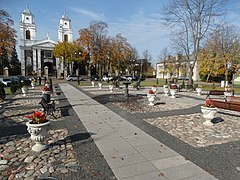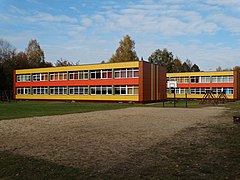Lazdijai
Lazdijai | |
|---|---|
City | |
 Lazdijai district municipality building | |
| Coordinates: 54°14′N 23°31′E / 54.233°N 23.517°E | |
| Country | |
| Ethnographic region | Dzūkija |
| County | |
| Municipality | Lazdijai district municipality |
| Eldership | Lazdijai city eldership |
| Capital of | Lazdijai district municipality Lazdijai city eldership Lazdijai rural eldership |
| First mentioned | 1570 |
| Granted city rights | 1597 |
| Population (2001) | |
| • Total | 5,140 |
| Time zone | UTC+2 (EET) |
| • Summer (DST) | UTC+3 (EEST) |
Lazdijai ( Template:Lang-pl) is a small town in Lithuania located about 7 km (4.3 mi) east of the border with Poland.[1][2]
History
It was established by Sigismund II Augustus in 1570 and granted Magdeburg Rights by Sigismund III Vasa in 1587.[3]
On November 3, 1941, 1,535 Jews were murdered in Lazdijai, including 485 men, 511 women and 539 children[4] The perpetrators were members of the Rollkommando Hamann, local policemen and Lithuanian nationalists.
In 1990 Lithuania declared independence from the Soviet Union, and new check points between the borders Poland and Lithuania were established and Lazdijai became the center that oversees and continues to regulate these operations. It is the birthplace of Lithuanian politician and producer Arūnas Valinskas and of Russian-American composer and violinist Joseph Achron.
Gallery
-
Independence Square in Lazdijai (2006)
-
Square near the church
-
Vilnius Street in Lazdijai
-
School of Arts in Lazdijai
-
Square near the Cultural Centre of Lazdijai
-
Education Centre of Lazdijai
-
Police commissariat in Lazdijai
-
School Vyturėlis in Lazdijai
-
Sports Centre of Lazdijai
References
- ^ "Istorija ir Kultūros paveldas". lazdijai.lt. Retrieved 21 December 2019.
- ^ "Lazdijai". vle.lt. Retrieved 21 December 2019.
- ^ Encyclopedyja Powszechna (Universal Encyclopedia). Vol. 17 (in Polish). Warszawa: S. Orgelbrand. 1864. p. 655.
- ^ "Holocaust Atlas of Lithuania". holocaustatlas.lt. Retrieved 2017-07-15.
External links
- The murder of the Jews of Lazdijai during World War II, at Yad Vashem website.












